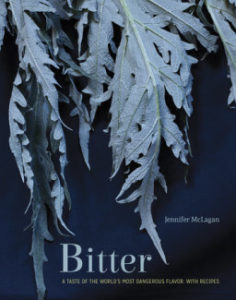“Born to be Bitter” is the first of six sections in the book, Bitter, by Jennifer McLagan, c2014. In it she describes the bitter taste stars of the vegetable kingdom along with fruits, drinks like coffee and tea, bitters for alcoholic drinks, and chocolate and tobacco (surprise!) rounding out the selection.

Taking it for granted that the reader already knows something about taste, McLagan avows the abhorrence we normally have for bitterness. Most of us would prefer sweet as a flavor option in most dishes and foods. The bitter option, though, is often consigned to forbidden substances and those that are intrinsically bad for us, like inedible fruits or vegetables.
McLagan lives in Toronto. She’s a classically trained chef in the French tradition and has traveled and worked in kitchens world-wide. Her professional focus is food writing (she’s written several books including one on enjoying animal fat) and in Bitter, she discovers bitter as a taste sensation, rather than a flavor to avoid.
Is bitter opposite of sweet?
To discover bitter, or should I say re-discover it, is to add a dimension of taste to your palate. You’ve heard this before—that human tongues recognize six different tastes. So, preferring a single taste sensation, like all sweet and nothing but—ends up overwhelming our taste buds and compromising diet plans in the process.
Desire for a single taste also means that we loose the natural curiosity for all six tastes—sweet, sour, salty, pungent, bitter, and astringent—the full-palate of tastes human tongues can recognize. The bitter taste, the opposite of sweet, is seen by McLagan as sophisticated.
Nutritionists and aspiring cooks know that the bitter tastes, when incorporated into a dish, add health benefits you may not have expected. Bitters are like probiotics, working towards optimal digestion. Bitter taste stimulates digestion, and as Guido Mase says, “Keeps things humming along”.
For those of us who aren’t sure of either the names or of type of flavor bitter will impart to a dish, McLagan explains plainly in both text and photographs with Aya Brackett’s strikingly beautiful images.
Take a second look at rapini, escarole, the endives, and dandelion. Know that your passionate love of salads with arugula and tarragon presupposes that you actually do love bitter, if secretly.
Look into the heart of a curly endive, and you see its lighter color, while the outer leaves darken to a deeper green. McLagan says to lightly cook those outer leaves to “temper their bitterness” and reserve the tender inner leaves for salad.
Salad dressings like Hot Bacon or Anchovy are favorites of McLagan’s for matching bitter with fat to achieve a sophisticated omnivore palate. The chef herself, a native of Australia, is keen on the European style of preparing a dish, dressed with a French accent, and modified by travels worldwide and in her.
McLagan’s knowledge of taste is defined broadly. Years of European style cuisine have tended towards a preference of meat and fowl. And yet Bitter is almost entirely about and focused on plants. The fact that many of her recipes tend to feature animal-based dishes is meant to amplify the nature of bitter—that it stands up to heavy, fatty foods.
She explains the nature of bitter by sorting out aspects of it complimented by one or more of the other five tastes we recognize. Well-known flavors are: sweet, sour, salty. We also know pungent well— the kind in pickles that have been marinated in a salty brine with vinegar and spices. When cured and ready, the pickles can produce a mild sweat, at the very least a hot sensation on the tongue.
Special inserts to the sections offer the history of bitterness in alcoholic beverages like beer and cocktails. Bitters create character distinction for branded cocktails—the ones you know by name have specific recipes and thus include bitters to impart the expected flavor.
In any of the special inserts by McLagan, the reader gains an entire perspective on bitter. Popping up at random in the chapters, inserts are actually mini-essays, engagingly written as “The World’s Most Expensive Vegetable”. It’s about eating hop shoots, or “Drink that Built an Empire”, about gin and tonic; or “Bitterest Plant in the World”, about an herb, gentian, found in Angostura bitters and the soft drink of yore, “Moxie”.
McLagan makes note of the personal side of bitter, as the reader might be wondering specifically about how to relate to the taste. Her essays prove what on earth could be healthy, in “Healthy Bitter”; whatever are “Phytochemicals”, what could be understood by “Talking Bitter”, or “Hearing Taste”.
Incorporating bitter into your kitchen repertoire is what, according to McLagan, makes you a savvy chef. If you try a little bit at a time, bitter will grow on you. And you’ll find yourself discovering more about bitterness and how attractive it is. According to McLagan, “food without bitterness lacks depth and complexity.”



